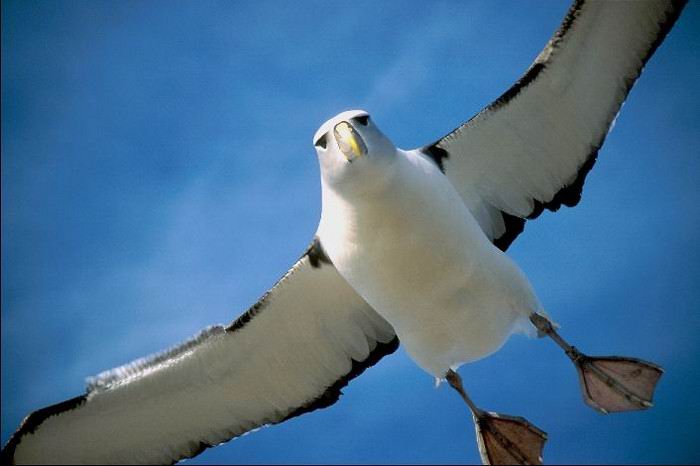Albatross - Great Wandering
Albatross, Snowy Albatross, Great Albatross Scientific Name: Diomeda exulans
Tue, 29th April, 2025 - 8:45 pm GMT
Sponsor Ads:

Alternative Name
Albatross, Snowy Albatross, Great Albatross Scientific Name: Diomeda exulansBasic Info
As the largest of all seabirds, the Wandering Albatross can have a wingspan of up to three and a half meters! The wings are usually narrow and quite powerful. Wandering Albatrosses have large, webbed feet. Their long bills are hooked and quite sharp. The plumage of these birds may be black and white. Usually, the Wandering Albatross measures over one meter in length and weighs between eight and 12 kilograms. The female is generally smaller than the male.
Health
The Wandering Albatross is not a particularly graceful bird on land and has great difficulty moving over the earth. It does not do very well when flying without a wind, either, and will often come to rest on the ocean if there are no suitable air currents. Breeding The Wandering Albatross does not reach sexual maturity until it is between seven and 16 years of age! At this point, it will return to the place of its birth to find a mate. Breeding season generally lasts from December through July. Males will usually greet a female and dance in front of her. The Wandering Albatross mates for life, usually, and renews the courtship each year. After mating, only one chick will be born. The egg will incubate for about 78 days, with the parents taking turns sitting on the egg. Usually each bird will remain on the egg for two to three weeks, losing a significant amount of weight. The parents will raise it, although they are frequently absent from their nest. Usually, they only return to incubate the egg and later to feed the chick, spending the remainder of their time at sea. They will feed the chick a very large meal about once every ten days. It will not leave the nest for about nine months. Wandering Albatross generally only mate once every other year.Habitat
It is usually found in the southern hemisphere, over oceans and small deserted islands between Antarctica and the Tropic of Capricorn.Behavior
The Wandering Albatross has fascinated sailors for years, and continues to follow fishing boats as it has for centuries. Wandering Albatrosses usually feed on squid, although they have been known to feed on fish waste thrown from fishing boats. These birds can cover incredible distances, and birds wearing trackers have been known to traverse distances of 1,000 kilometers in just one day! The main flying strategy seems to be soaring, efficiently using wind currents to carry the bird to a desired location. Usually, Wandering Albatrosses are found alone, more commonly seen far from shore. When they find a lucrative source of food like a fishing boat, up to seven birds may be seen in the same area. The Wandering Albatross does not return to land until it is ready to mate. At this time, it will land on the island it was born on in order to breed. Outside of the breeding season, the Wandering Albatross spends all its time at sea. It even sleeps floating on the surface of the water. In still air, however, the Wandering Albatross may have a bit of difficulty with a take off. They are also quite bad at landing and may often crash. They do not walk gracefully on land, either. In the air, the Wandering Albatross is the picture of grace. These large birds can live up to 80 years.Origin
Australia and New GuineaHistory
The Wandering Albatross has always been greeted with mixed emotions. Although it was considered to be a indication of storms, it could also mean a good strong wind for sailors. Sailors thought it extremely unlucky to kill the Albatross, as one belief stated that it was the reincarnated form of a dead sailor. Coleridge's famous Rime of the Ancient Mariner illustrates this legend. By the 1800's, Wandering Albatross were killed in large numbers for their feathers, used to stuff pillows and mattresses. The feathers and sometimes entire wings were used to adorn ladies' hats. In recent years, the Wandering Albatross has suffered, becoming entangled in fishing lines or nets, dying from ingestion of plastics or other wastes, or losing its food due to the depletion of fishing stocks.Common Foods
N/ASponsor Ads:
"To secure ourselves against defeat lies in our own hands, but the opportunity of defeating the enemy is provided by the enemy himself." -- Sun Tzu, The Art of War
Albatross - Great Wandering
Coded by: BGID® | ALL RIGHTS RESERVED Copyright © 2000-2025
Disclaimer | Privacy | Report Errors / Contact | Credits








 President of the United States of America - Real Estate mogul, Pageant owner and now one of the most controversial men in political history.
President of the United States of America - Real Estate mogul, Pageant owner and now one of the most controversial men in political history.  Politician, US Vice President and President of the USA - Joseph Robinette Biden Jr.
Politician, US Vice President and President of the USA - Joseph Robinette Biden Jr.  versus
versus  Russia: 'The Evil Empire'? Are they all that bad or is it just the USA trying to portray Russia as bad because they are a world power with land bigger and a society very different from the USA ideal?
Russia: 'The Evil Empire'? Are they all that bad or is it just the USA trying to portray Russia as bad because they are a world power with land bigger and a society very different from the USA ideal?  Global warming has been in and out as the "latest" hot topic for many years. It is, according to modern scientists, the result of man-made industrial pollutants, clearing forested areas, agriculture, etc. But now they are thinking it started way before the Industrial Revolution...
Global warming has been in and out as the "latest" hot topic for many years. It is, according to modern scientists, the result of man-made industrial pollutants, clearing forested areas, agriculture, etc. But now they are thinking it started way before the Industrial Revolution... 
 Corona virus
Corona virus 
 Users with wide screen monitors can benefit from more content on every page.
Users with wide screen monitors can benefit from more content on every page.